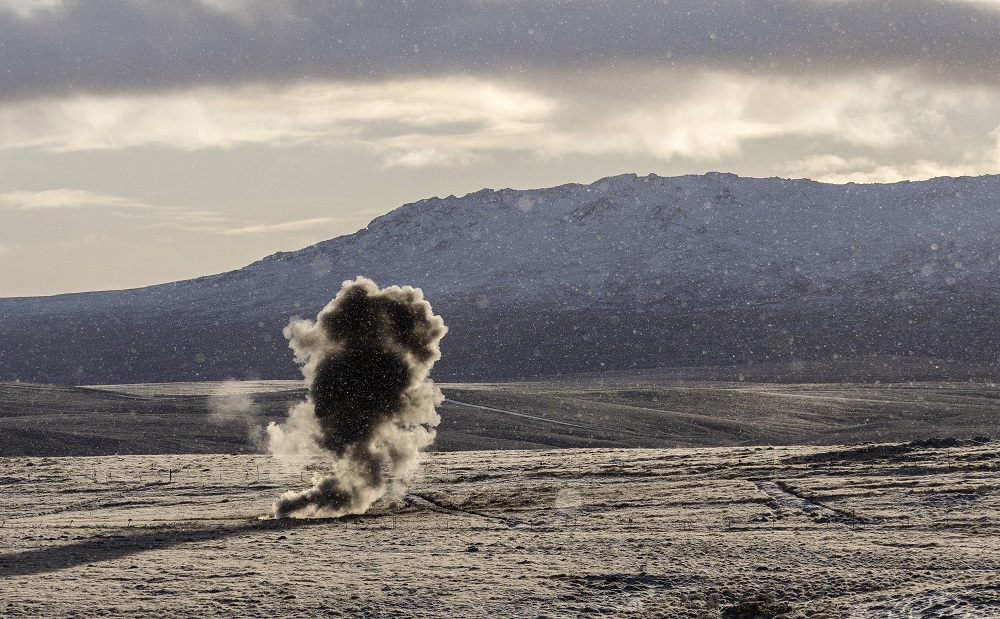Casualties mount despite cluster munitions ban
Posted By Leonard Blazeby on August 19, 2020 @ 06:00

Their bright colours attract children, arousing curiosity. And it is children who often trigger their explosion, losing an arm, a leg or a life.
Cluster munitions are one of the world’s most treacherous weapons.
Dropped from the air or launched from the ground, cluster munitions are intended to strike targets with small explosive submunitions over an area the size of several football fields. However, these bomblets often fail to detonate as intended, lying on the ground for years, even decades, after a war has ended, waiting to kill or maim any child, woman or man who touches or steps on them.
This deadly legacy of war is not inevitable. Protecting civilians and ensuring respect for international humanitarian law are integral parts of the mission of the International Committee of the Red Cross (ICRC). Both of those goals involve working to prevent and mitigate the effects of cluster munitions and to improve affected people’s rehabilitation and quality of life.
The good news is that there is a treaty banning these indiscriminate and unacceptable weapons. This month marks the 10th anniversary of the United Nations Convention on Cluster Munitions, which came into force in August 2010. I was fortunate enough to be present at the 2008 meeting in Dublin when the treaty was adopted, and to accompany the then ICRC president, Jakob Kellenberger, to the signing ceremony in Oslo in December of that year.
Australia was an original signatory to the convention. It was represented at the ceremony by former foreign minister Stephen Smith, who signed the treaty for Australia along with 93 other nations. I saw the enthusiasm of many states in banning these insidious weapons.
Civil society, in particular, the international Cluster Munitions Coalition (CMC), also played a crucial role in the advocacy for and creation of the convention. Thomas Nash, a New Zealander, served as coordinator of the CMC throughout the global campaign and steered civil society’s contribution through the successful negotiations and beyond. Along with the ICRC, the CMC was extremely effective in communicating the benefits of a treaty, contributing to the policy debate and encouraging states to support the treaty process.
Since then, 108 countries have joined this important humanitarian treaty, which comprehensively bans the use, production, transfer and stockpiling of these weapons. Countries that have joined the convention have committed to destroying their stockpiles, clearing contaminated areas and supporting the victims of cluster munitions.
Together they have eliminated nearly 1.5 million stockpiled cluster munitions, ensuring that they will never be used. Large areas of land have been cleared in some countries, meaning children can walk safely to school, and adults can travel to work without fearing the worst.
The convention has led to a substantial reduction in the use of these weapons, even by states that have not yet joined it, saving countless lives. Australia passed legislation to implement the convention and became a party to it in 2012.
The convention contains robust provisions on assistance for people affected by cluster munitions. It requires state parties that have victims of cluster munitions on their territory or under their control to provide for their medical care and physical rehabilitation, as well as psychological support and social and economic inclusion. State parties must assess domestic needs in these areas, develop plans and mobilise resources to meet them. This is the first time that such a detailed provision on assistance for people affected has been included in an international humanitarian law treaty.
Despite these successes, scores of people continue to be killed and injured every year. In recent years, the use of cluster munitions has been reported in Syria, Yemen and Libya, but other countries have also been affected, and it’s civilians who continue to bear the brunt of their devastating effects.
Moreover, many areas remain contaminated by these munitions long after they were dropped. Clearing them is a slow and dangerous task because of the number of unexploded bomblets and their instability—the slightest movement can trigger an explosion. Let us be unequivocal: any use, anywhere, by anyone, must be condemned.
But the vital work continues. Monitoring compliance by state parties with their treaty obligations and promoting universal adherence to the treaty remain important tasks. As does reinforcing the stigma against cluster munitions and the norm of a global ban.
Switzerland will host and preside over the Convention on Cluster Munitions second review conference, set to meet in Lausanne from 23 to 27 November. Such conferences are held every five years and play a vital role in defining the progress made under a convention. Together with the ICRC, states will work to advance the convention’s goals, notably by urging others that have not yet joined the treaty to do so at the earliest opportunity.
These commitments are critical if we are to achieve a world free of cluster munitions. We must ensure the complete destruction of stockpiles and clear all contaminated areas. And we must pledge our assistance for all people affected by these weapons. The Convention on Cluster Munitions has helped considerably to protect civilians from the effects of war.
Collective action is powerful: states, international organisations and civil society working together can achieve real and valuable change. The lives of countless civilians depend on it.
Article printed from The Strategist: https://www.aspistrategist.org.au
URL to article: https://www.aspistrategist.org.au/casualties-mount-despite-cluster-munitions-ban/
Click here to print.